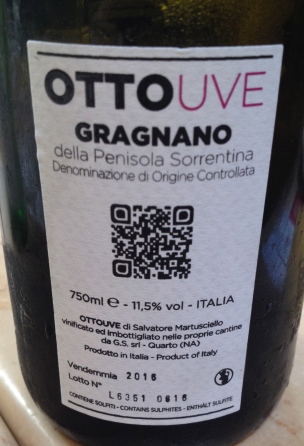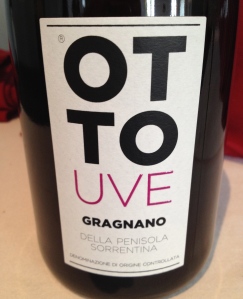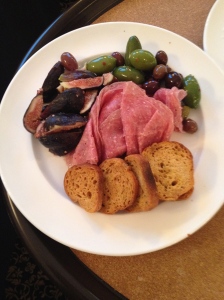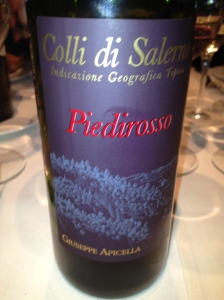In February, I received an invitation from an acquaintance to try a new restaurant in New York. But since I was in Naples, Italy, I responded that I could not attend. “In that case,” came the reply, “you must visit the Pizzeria Concettina ai Tre Santi. My mother, the princess, owns the building and lives upstairs.” It sounded like a great invitation but unfortunately my schedule was set and we were leaving Naples shortly so I had to decline.
I had an appointment to meet with winery owners Gilda Guida and her husband Salvatore Martusciello.
I met Gilda last year on the Campania Stories tour for journalists.

Gilda Guida
At the Pizzeria Parule in Ercolano I drank the best Gragnano, which I consider the perfect pizza wine, that I have had. Gilda told me it was her and her husbands’ wine. Salvatore had 26 years of experience in his family winery before going out on his own. His family’s was the first winery to produce sparkling wine in Campania over 30 years ago. Their winery is in Quarto. We had a long conversation about wine and pizza and she had invited me to visit.

Salvatore in the Vineyard
Gilda and Salvatore picked us up in front of our hotel and drove us to see one of their vineyards located on a high hill in Gragnano with great views.
Salvatore said the training system is the spalliera. He said he does not own any vineyards but has arrangements with a number of small vineyard owners in the area. All of the arrangements are based on a handshake, he said. Salvatore showed us around the vineyard pointing out where the different grapes were grown. He spoke very enthusiastically about the terroir, the native grapes and this part of Campania in particular.
After we visited the vineyard, Gilda and Salvatore suggested we go for pizza to what they consider the best pizzeria in Naples right now. To my surprise, it was Concettina ai Tre Santi (S.Antonio, S.Anna and S. Alfonso) the same place my New York contact had recommended. I could not believe the coincidence! We called the Principessa who graciously came down to meet us and took us on a tour of her grand apartments.

Ciro at the Wood Burning Oven
At the restaurant, we met the pizzaiolo/owner Ciro Oliva who is only 24 years old. The pizzeria is not in the best part of Naples,Via Arena della Sanità 7, but Ciro has become famous because of his great pizza and his charity work for the children and needy people in his neighborhood. The place is always crowded.
Ciro brought out a succession of fritti, fried appetizers, including little fried pizzette with different toppings,
 little rice balls filled with cabbage and cheese, fried pasta and fried polenta. With them we drank Salvatore’s Trentapioli Spumante Brut Asprinino d’Aversa. It was an excellent combination.
little rice balls filled with cabbage and cheese, fried pasta and fried polenta. With them we drank Salvatore’s Trentapioli Spumante Brut Asprinino d’Aversa. It was an excellent combination.
“Trentapioli “Spumante Brut Asprinino d’Aversa 2015 (Metodo Martinotti Brut) Made from 100% Asprinio d’Aversa from the tree-lined historic vineyard in the town of Casapesenna, in the Agro Aversano. The name of the wine Trentapioli comes from the thirty pegs of the ladder used to climb up to harvest the grapes
The vines are typical Alberata Aversana. In the Alberata training system, which dates back to the Etruscans, the vines grow up to 18 meters tall and are tied to tall poplar trees. The harvest is manual because ladders up to 20 meters high are used in order to reach the grapes. The grapes are placed in 18kg boxes. The soil is alluvial, volcanic and of medium texture. After crushing, the must is immediately separated from the skins and placed in an autoclave for a second fermentation. The wine is matured on its lees in an autoclave for about 90 days and was bottled on December 3. The wine has nice citrus fruit aromas and flavors with a hint of lime, herbs and good acidity. The wine can age for 5 to 6 years.

Then Ciro made a number of pizzas for us to share using local cheeses, vegetables and meats.
With the pizza we drank Salvatore and Gilda’s Ottouve Gragnano della Penisola Sorrentino 2015. This is a slightly frizzante red wine which Salvatore likes to describe as vivace (lively). It was good as I remember it from last year.
Ottouve Gragnano della Penisola Sorrentina DOC Made from 60% Piedrosso, Aglianico, Sciascinoso and 40%, Suppezza, Castagnara, Serbegna, Olivella and Sauca. That is why the wine is called eight grapes. Salvatore said it was a tribute to the lesser known grapes of the area. The training system is espalier.
The vineyard is at 300 meters. For 2015 the harvest began on September 24th and ended on October 8th. The grapes were hand harvested into boxes of 20kg. After destemming and crushing, maceration with the skins lasts for 5 days, soft pressing of the grapes in a pneumatic press and fermentation in temperature controlled tanks at about 20C
The 2015 vintage was bottled on December 1st. The wine should be served chilled and should be drunk within two years after it was bottled. This is the perfect pizza wine but it also goes with many other southern Italian dishes. It is only 11.5% alcohol. This is a wine with light foam when poured, hints of strawberry, red currants and a hint of spice.
Salvatore also produces :
Settevulcani Falanghina dei Campi Flegrei DOC
Settevulcani Piedirosso dei Campo Flegrei DOC
Ottonove Lettere della Penisola Sorrentina DOC
After having a very enjoyable time, making new friends, sightseeing, eating pizza and drinking wine, we did not have enough time to taste these wines. I guess I will just have to return again. But Salvatore and Gilda had one more surprise for us. They took us to visit their vineyard in the Campi Flegrei called Foglie di Amaltea. It overlooks a large volcanic lake though they do not currently produce grapes there.
 Fried Burrata-At first I thought this was an arancini or rice ball, but Roberto told us it was a large burrata cheese, rolled in a batter and deep fried. When we cut into the crusty exterior, small balls of mozzarella in cream tumbled out.
Fried Burrata-At first I thought this was an arancini or rice ball, but Roberto told us it was a large burrata cheese, rolled in a batter and deep fried. When we cut into the crusty exterior, small balls of mozzarella in cream tumbled out. Arancini – Roberto’s rice balls (top left) are filled with fresh mozzarella and Italian roast pork.
Arancini – Roberto’s rice balls (top left) are filled with fresh mozzarella and Italian roast pork.
 Meatballs– Traditional Italian beef meatballs. Roberto said this is mother’s recipe and they were very good with a firm texture and very meaty.
Meatballs– Traditional Italian beef meatballs. Roberto said this is mother’s recipe and they were very good with a firm texture and very meaty. Cantina Federiciane Montelone di Napoli Gragnano DOC Sorrento Peninsula 2019, made from Piedirosso and Sciascinoso. Fermentation with selected yeast takes place in temperature controlled autoclaves. This is a fizzy red wine that when poured has a lot of foam that quickly disappears in the glass. It is fruity with red fruit aromas and flavors, hints of raspberries and strawberries, and easy to drink. In Naples they often drink sparkling beverages with pizza and Gragnano goes very well with pizza Margherita. Sciascinoso, also know as Olivella, is used as a blending grape. The clusters and berries are large and it is a late ripening variety.
Cantina Federiciane Montelone di Napoli Gragnano DOC Sorrento Peninsula 2019, made from Piedirosso and Sciascinoso. Fermentation with selected yeast takes place in temperature controlled autoclaves. This is a fizzy red wine that when poured has a lot of foam that quickly disappears in the glass. It is fruity with red fruit aromas and flavors, hints of raspberries and strawberries, and easy to drink. In Naples they often drink sparkling beverages with pizza and Gragnano goes very well with pizza Margherita. Sciascinoso, also know as Olivella, is used as a blending grape. The clusters and berries are large and it is a late ripening variety. Margherita – Tomato sauce, fresh mozzarella, grana, basil and extra virgin olive oil.
Margherita – Tomato sauce, fresh mozzarella, grana, basil and extra virgin olive oil. Summer Pizza– Mozzarella prosciutto, whole tomatoes, basil and extra virgin olive oil
Summer Pizza– Mozzarella prosciutto, whole tomatoes, basil and extra virgin olive oil Pizza zucchini – Topped with walnut cream, zucchini, smoked provolone and extra virgin olive oil
Pizza zucchini – Topped with walnut cream, zucchini, smoked provolone and extra virgin olive oil  Tiramisu – the classic, with coffee, sponge cake and chocolate.
Tiramisu – the classic, with coffee, sponge cake and chocolate. Caprese – Moist flourless chocolate cake with ice cream
Caprese – Moist flourless chocolate cake with ice cream Nutella – fried dough with Nutella and ice cream.
Nutella – fried dough with Nutella and ice cream. The “Keste Mobile” now delivers all over
The “Keste Mobile” now delivers all over







































